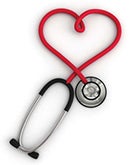Cardiac CT & MRI

Advanced Computed Tomography (CT or CAT) scan, uses X-rays — in many layered slices — to produce a detailed look at internal structures. Using this imaging technology in combination with an intravenous (IV) contrast (dye) helps clearly show the heart, vessels and circulation.
When the procedure is used to look at the heart, it may be referred to as coronary CTA (angiography), cardiac CT or CAT scan. All of these terms refer to the same test.
Learn How to Prep for a CAT Scan
What is the purpose of a CT Scan?
A CT Scan is used to look inside the heart to fully evaluate the heart muscle, pulmonary veins, coronary arteries, thoracic and abdominal aorta and more. The test can also be performed using Magnetic Resonance Imaging (MRI), a non-radiation based study that uses high powered magnets to see inside the body. Your doctor may prefer one modality over the other based on your symptoms or physical limitations you may have.
Both are non-invasive outpatient procedures. Once in the procedure room, a radiology technologist will start an IV to administer the contrast solution. This is normally put in a vein in your arm or hand.
Once on the scanning table, electrodes that measure the electrical activity of the heart will be attached to your chest. You will raise your arms over your head for the test. If you are having an MRI, you will be enclosed in the magnet, which may be claustrophobic for some.
Talk with your doctor about medications to help you relax before the test. After the test, you can continue with your regular daily activities.
Calcium Score
To evaluate your risk for heart disease, your doctor may recommend a CT scan that provides a calcium score, which shows if there is coronary calcification in the arteries. If found, it can help predict future cardiovascular disease.
Those most at risk include those with a family history of coronary artery disease (CAD), men over age 45 and women over age 55, current or previous smoker, those who are already overweight and have been diagnosed with high cholesterol, high blood pressure or diabetes.
While this is an excellent test in predicting particular types of coronary artery disease, it is not definitive due to certain soft plaques (buildup) not being visible using this technology.
The scan is synced with your heartbeat to look for calcium deposits within the arteries. Once the test is finished, if calcium is noted, it will be given a score that estimates the extent of coronary artery disease.
Once you know your score, you and your doctor can discuss steps to take to lower your risk of developing heart disease. This test is normally performed under the guidance of a radiologist who is trained in cardiovascular imaging.
How to prepare for a Cardiac Computed Tomography - CT or MRI
On the day before your test, avoid caffeinated drinks, energy pills containing caffeine or medications such as Viagra. Talk to your doctor if you have questions about which medications are safe for you to take prior to testing.
If calcium scoring is included in your exam, you may have a blood lipid panel done prior to the imaging test, which requires fasting for 12 hours.
On the day you are scheduled for your test, do not eat four hours prior to your appointment. However, you may drink water.
Be sure to talk with your doctor and technologist if you have diabetes, are pregnant, allergic to shellfish or iodine, older than 60 and have kidney disease.
After the Cardiac CT scan or MRI, images are reviewed by your doctor. You will be scheduled for a follow-up appointment to discuss the results and determine the next steps in taking care of your heart.